Medline Steel Rollator Knockdown Rolling Walker User Guide

Content
Introduction
The Medline Steel Rollator Knockdown Rolling Walker is a versatile mobility aid designed for comfort and convenience. Launched on August 2, 2023, this walker features a padded seat and 6-inch wheels, making it suitable for both indoor and outdoor use. Priced at $69.99, it supports a weight capacity of up to 350 pounds and offers tool-free assembly for easy setup. Manufactured by Medline, it combines durability with user-friendly features for enhanced mobility.
Rollator Parts List
Note: You may wish to request a set up and operating demonstration with your local Medical Equipment provider or pharmacy.
- 1 Rollator Frame
- 1 Backrest with Pad
- 2 Handlebars with Brake Assembly 1 Bag
- 2 Front Wheels
- 2 Rear Wheels
- 2 Four Point Knobs
- 2 Screws and Curved Washers
- 4 Triangular Knobs
Specifications
- Sturdy steel frame for durability and stability
- Knockdown design for easy assembly and disassembly
- Adjustable handle height to fit different user preferences
- Large 7.5-inch casters for smooth movement on various surfaces
- Under-seat storage basket for carrying personal items
- Weight capacity of up to 350 lbs
Assembled Rollator

- Handgrips
- Adjustable Handlebars
- Four Point Knobs
- Backrest
- Backrest Attachment
- Seat
- Brake Lock
- Brake Cables
- Folding Support Bracket
- 6" (15.2 cm) Front Wheels
- 6" (15.2 cm) Back Wheels
- Triangular Knobs
- Brake Shoe
Assembly Instructions
- Carefully remove the rollator components from the shipping carton. Refer to diagram (Figure 1) as needed.
- Examine all parts for shipping damage. DO NOT use the rollator if there is apparent damage or if any parts (other than the bag) are missing. If there are missing or damaged parts, please call Medline Customer Care toll free at 1-800-MEDLINE.
- Remove plastic cover from wheels. Check all of the wheels to see that they are in good working order and roll freely. Please also ensure that all four wheels touch the ground.
- Unfold the rollator by pushing down on the folding bracket (I) until the frame is in full extension.
Note alignment of wheels, backrest and brake handles to frame (Figure 2).
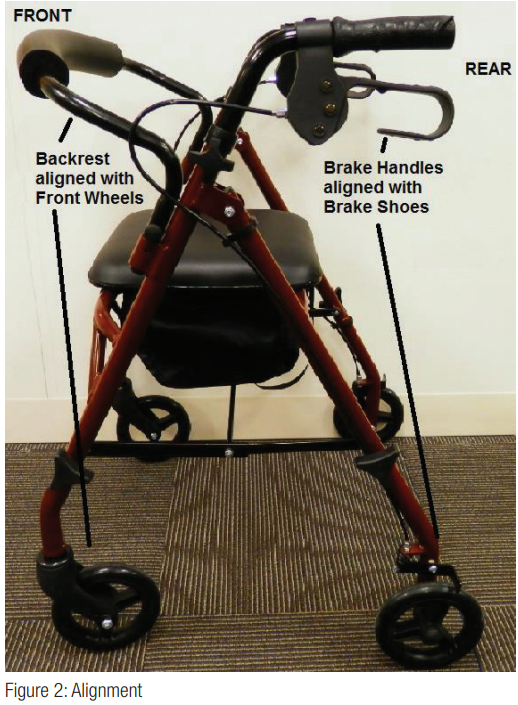
- Lay the rollator over on one side.
Insert the front wheel assembly (Figure 3 and Figure 4) on the side facing up. Insert one triangular knob (L) (Figure 5).

Insert the rear wheel assembly (Figure 6 and Figure 7) on the side facing up. Make sure that the brake shoe (M) is toward the outside of the frame. Insert one triangular knob (L) (Figure 8).

Insert the handle/brake handle assembly (B and G) into the frame (Figure 9). The brake cables should be on the outside of the handlebars and frame. Ensure excess brake cable loops towards the front of the rollator.
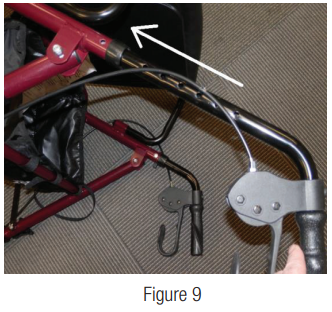
Align one of the holes to the hole in the frame and insert the four point knob, washer and bolt (C) (Figure 10) to hold the handle/brake handle assembly in place.
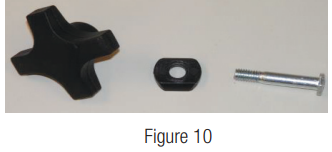
Insert the bolt into the 6 sided hole in the frame (Figure 11). Make sure the bolt head recesses into the frame (Figure 12).
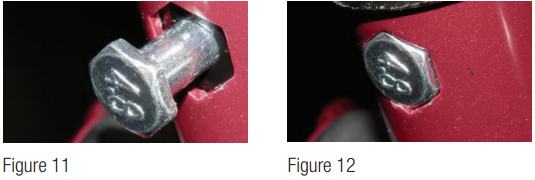
Slide the washer onto the other end of the bolt with the curved side facing the frame (Figure 13)
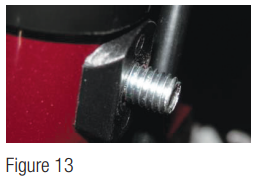
Screw on the four point knob (C) (Fig 14 and Fig 15).
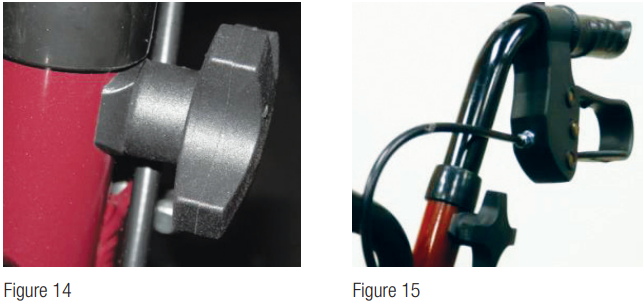
- Turn the rollator onto the other side so that the wheels that were just installed are on the floor. Repeat steps 7 through 10 above for the other side.
- Stand the rollator up so all 4 wheels are on the floor. Make sure all 4 wheels are contacting the floor.
Insert the backrest (D) so that the curved portion faces the front of the unit. Make sure that the button snaps firmly into the hole so the back is secure (Figure 16).
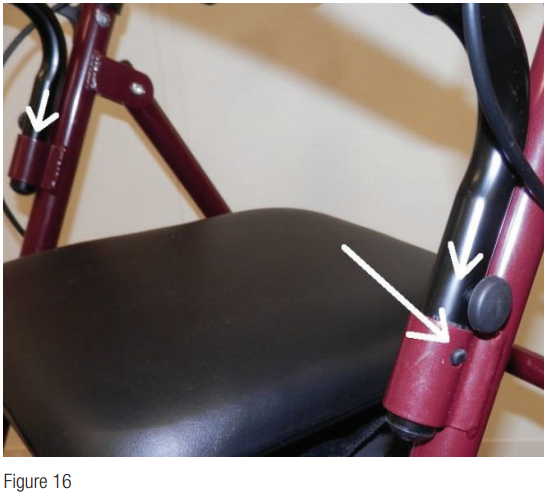
- Adjust the height of the handlebars (B) for proper fit. To determine proper height, stand upright behind the rollator with shoulders relaxed, arms hanging at your side and eyes looking straight ahead. Standing in this position, the handgrips (A) of the rollator should be adjusted to a height even with the wrists. This will position the arms at an approximate 20º to 30º bend when using the rollator. See Figure 16.
You will have to remove the four point knob (C) to adjust the height of the handles. Do one side at a time. Secure the handlebars at the closest hole to the desired height.
Repeating Step 10, secure the four point knob (C) to the screw. (Important: Hand Tighten Only!)
Description
The Medline Steel Rollator Knockdown Rolling Walker is engineered with user comfort and safety in mind. The rollator features a robust steel frame that ensures stability and support, while the knockdown design makes it easy to set up and take down as needed. The adjustable handle height allows users to customize the rollator to their comfort level, and the large casters provide smooth navigation over different terrains.
The under-seat storage basket is a convenient feature that allows users to carry personal items such as groceries, books, or medical supplies. This rollator is also equipped with a secure braking system, ensuring safe use and preventing accidental rolls.
Operating Instructions
Using the rollator as a walker:
For proper positioning and use of the rollator, imagine a line drawn across the back of the rear wheels. Part of one foot should be slightly ahead of that line as you walk.
Using the rollator as a seat:
- Push the rollator to the desired location.
- LOCK the brakes BEFORE sitting.
To Operate the Brakes:
- To slow down, squeeze the brake handles up (Figure 17).
- To lock the brakes, push down on the brake handles until you feel or hear the brakes click into the locked position (Figure 18). If the brakes have been adjusted but the rear wheels on the rollator move while the brakes are in the locked position, DO NOT use the rollator.
To release the brakes from the locked position, simply pull up on the brake handles (Figure 17).
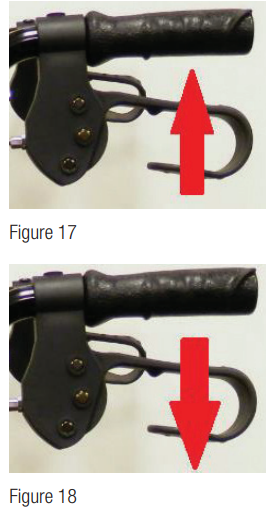
CAUTION: After making any adjustments to the rollator brakes, you must test the brakes before the rollator is used. See Maintenance Instructions.
Setup Guide
To assemble the Medline Steel Rollator Knockdown Rolling Walker, follow these steps:
- Unpack all components from the box and ensure all parts are included.
- Attach the front and rear wheels to the frame using the provided screws.
- Adjust the handle height to your preferred level.
- Attach the storage basket under the seat.
- Test the rollator to ensure all parts are securely attached and functioning properly.
For operation, simply unfold the rollator, adjust the handles if necessary, and use the brakes to control movement.
Safety Instructions
To ensure your safety in using the Medline rollator, the following safety information and all instructions must be followed.
GENERAL CAUTIONS
- DO NOT use this product without first reading and understanding the instructions contained in this manual. If you are unable to understand the warnings, cautions, or instruc-tions, contact a healthcare professional, dealer, or technical personnel before use. Failure to do this may result in bodily injury or damage to the device.
- DO NOT self-propel the rollator while seated.
- Rollators are intended for individual use only and are NOT TO BE USED AS A WHEELCHAIR. Serious injury to the user and/or damage to the rollator’s frame or wheels may result from improper use.
- DO NOT use the rollator to walk backwards, down gradients or to climb stairs, curbs, or to go over obstacles. Serious risk of fall or injury may occur.
- The backrest is intended to provide back support while seated. The backrest is not intended to support full body weight. Avoid leaning while sitting as this may result in fall.
- All wheels must be in contact with the floor and/or ground at ALL TIMES. This will ensure the rollator is properly balanced.
- DO NOT exceed the maximum weight capacity (including bag contents) or serious injury could result. Maximum weight capacity: 350 lbs (159 kg)
- Items should be placed completely in bag and should not protrude. Excess weight may cause the rollator to tip, resulting in bodily injury or rollator damage
- The bag located under the seat has a weight limitation of 10 lbs (4.5 kg).
- Before each use make sure the rollator frame is fully opened.
- Periodically wipe down the rollator with a soft cloth and nonabrasive cleaner.
SEAT CAUTIONS
The brakes MUST be in the locked position BEFORE sitting on the seat.
- DO NOT sit on the rollator while it is being loaded into a vehicle or while it is being transported in a vehicle.
- DO NOT use the seat to transport people or objects.
- DO NOT sit on the seat when the rollator is on an incline.
BRAKE CAUTIONS
- Check the brakes for proper operation. Make sure that all parts are secure and that the moving parts are in good working order.
- Wheels should roll easily and not wobble.
- When rising from a lower position, DO NOT use the rollator to provide assistance to the user. If the rollator is used to pull the user up to a standing position, the rollator may move even if the brakes are in the locked position and this could result in a fall.
- DO NOT push the rollator while brakes are enabled. Brakes are to be used to keep the wheels from rolling. However, it may not prevent the rollator from moving if it is pushed.
Note: Only use accessories and spare parts authorized by Medline Industries
Rolling Walker Maintenance
Your rollator should be checked periodically to ensure the brakes are functioning properly and that all nuts and bolts are secure.
Periodically test the brakes by both walking and squeezing the brakes and by stopping, pushing down on the brakes to a locked position, and then trying to push the walker. If the brakes do not lock the wheels, the brakes need to be adjusted. If adjustment does not tighten the brakes, DO NOT use the rollator.
Adjustment of Brakes:
(There are 2 adjustments for each brake – one at the handle and one at the brake):
When adjusting the brakes on the rollator, keep in mind if you adjust it too far one way or the other, the lock will not function properly. Please test thoroughly and tighten all parts completely prior to using rollator.
- At the top of the rollator, find the adjustment nut which is located where the cable goes into the brake handle. This part is usually silver.
- If the brake is too tight, at the handles of the rollator, check to see if there is a gap between the adjustment nut and thumb screw. If there is, turn the adjustment nut counter-clockwise until it is flush up against the thumbscrew (You may need pliers to get started). Then rotate both together clockwise until it is tight against the handle; this should loosen the brake. If there is no gap and it is already tight against the handle, no further adjustment can be made.
If the brake is too loose (not locking), standing at the handles of the rollator, turn the adjustment nut and thumbscrew counter-clockwise (You may need pliers to get started). The thumbscrew and adjustment nut will push away from the handle and this will tighten the brake. Once the brake is adjusted properly, rotate just the adjustment nut clockwise until snug against the handle. There should now be a gap between the adjustment nut and the thumbscrew.
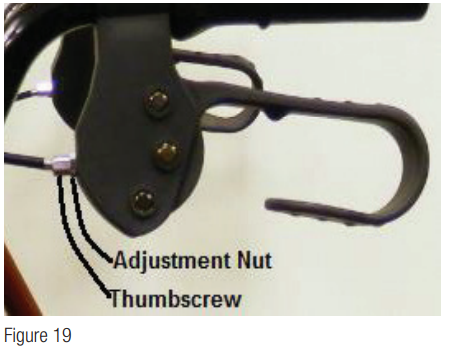
- At the bottom of the rollator, find the adjustment nut similar to the one located at the top. Hold the brake pad against the wheel. This will take the tension off of the cable.
- If the brake is too tight, check to see if there is a gap between the adjustment nut and thumb screw. If there is, pull up on the cable, and looking at the adjustment nut from the top, turn the adjustment nut counter-clockwise, screwing the adjustment nut to the thumb screw. Adjust to correct tension. If there is no gap, no further adjustment can be made here.
If the bake is too loose (not locking), pull up on the cable, then, looking at the adjustment nut from the top, turn the adjustment nut clockwise, screwing the adjustment nut to the bracket. There will now be a gap between the thumb screw and the adjustment nut. Adjust to correct tension.
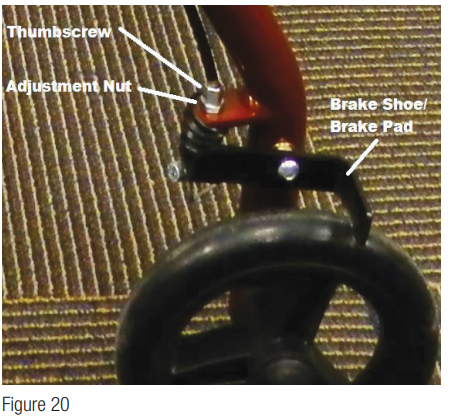
Troubleshooting
Common issues and solutions:
- Wobbly wheels: Check if the wheels are properly attached. Make sure all screws are tightened securely.
- Brakes not working: Ensure the brake cables are not tangled or damaged. Adjust or replace them if necessary.
- Handle height adjustment issues: Check for any blockages or debris in the adjustment mechanism. Clean and lubricate if necessary.
Instructions and warnings: Always follow the manufacturer's instructions for assembly and use. Ensure the rollator is used on flat surfaces and avoid using it on steep inclines or uneven terrain.
Pros & Cons
Pros
- Durable steel construction for long-lasting use
- Easy assembly and disassembly with knockdown design
- Adjustable handle height for user comfort
- Large casters for smooth movement on various surfaces
- Convenient under-seat storage basket
Cons
- May be heavier due to steel frame
- Limited foldability compared to some other models
- No seat cushion included (must be purchased separately)
Customer Reviews
Customers have praised the Medline Steel Rollator Knockdown Rolling Walker for its sturdiness and ease of use. Many appreciate the adjustable features and the spacious storage basket. However, some users have noted that it can be heavier than expected and that the folding mechanism could be improved.
Common complaints
Include issues with the brake system and the need for additional parts like seat cushions.
Warranty of Medline Steel Rollator Knockdown Rolling Walker
Your Medline walker frame is warranted to be free of defects in material and workmanship for a lifetime for the original consumer. This device was built to precise standards and carefully inspected prior to shipment. This Lifetime Limited Warranty is an expression of our confidence in the material and workmanship of our products and assures years of convenient, dependable service. In the event of a defect covered by this warranty, we will, at our option, repair or replace the device.
This warranty does not cover device failure due to owner misuse, negligence, or normal wear and tear. The warranty does not extend to non-durable components such as plastic accessories, brakes and grips, which are subject to normal wear and replacement. Non-durable components are warranted for 6 months.
Faqs
How do I assemble the Medline Steel Rollator Knockdown Rolling Walker?
What is the weight capacity of the Medline?
Can I use the Medline Steel Rollator Knockdown outdoors?
How do I adjust the handle height on the Rolling Walker?
Is there a storage basket included with the Medline Steel Rollator Knockdown Rolling Walker?
Can I fold the Medline Steel Rollator Knockdown Rolling Walker for storage?
What if my brakes are not working properly on my Medline?
How much does the Knockdown Rolling Walker weigh?
Can children use the Medline Steel Rollator Knockdown Rolling?
Is there a warranty on the Rollator Walker?
How do I maintain my Medline Steel Rollator?
Leave a Comment
